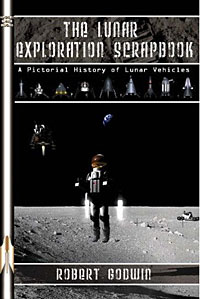|
|
Review: The Lunar Exploration Scrapbook
by Jeff Foust
Monday, January 21, 2008
The Lunar Exploration Scrapbook
by Robert Godwin
Apogee Books, 2007
softcover, 224 pp., illus.
ISBN 978-1894959-69-8
US$36.95
Last month NASA announced one key detail about the lunar lander that will be a key element in the agency’s plans to return to the Moon: its name. Little else is known about Altair, as the lander is now known, other than it will be able to host four astronauts on the lunar surface for a week. Although NASA has published some conceptual illustrations of the spacecraft, the actual design of Altair won’t be finalized until early next decade, assuming that the Vision for Space Exploration survives the change in presidential administrations next year in something resembling its current form. In the meantime, engineers at NASA and in industry will work on design studies and related work that will better define what Altair will look like. The question is, will they be as creative and inventive as their predecessors were nearly a half-century ago when they worked on the original push to the Moon, as so richly illustrated in the book The Lunar Exploration Scrapbook?
In The Lunar Exploration Scrapbook, author Robert Godwin reviews the history of designs of lunar spacecraft of all types, dating back to concepts by the British Interplanetary Society in the 1930s and 1940s (which, in one iteration, featured a lander not that dissimilar to the one eventually developed in the Apollo program.) The big focus of the book, though, is on the efforts to develop manned lunar spacecraft by NASA in the 1960s, especially lunar landers. The diversity of spacecraft included is remarkable: during that heady period, engineers came up with a wide range of designs not only for landers, but also rovers, “hoppers”, and a variety of other vehicles that could be used by astronauts on the Moon. This includes one proposal from Chrysler called the Manned Lunar Auxiliary Vehicle, which Godwin succinctly describes as “a nuclear tricycle”. Needless to say, many of these designs, including the plutonium-powered trike, didn’t get much beyond the concept stage.
| Among the designs included in the book is one proposal from Chrysler called the Manned Lunar Auxiliary Vehicle, which Godwin succinctly describes as “a nuclear tricycle”. |
The book doesn’t provide a comprehensive history of the development of these vehicles, nor is it intended to be one: Godwin himself writes in the introduction that this is not intended as a history book but instead “a fanciful attempt at presenting many extraordinary, and often extremely rare ideas, in one place.” There is a brief discussion of each design, supplemented with historical illustrations as well as new 3-D computer-generated images of the designs, created by the author. Unfortunately, the book only goes up through the Apollo era (including some designs for derivatives of the Lunar Module had the US continued human lunar exploration after the Apollo missions), so there’s no discussion of any of the designs that were drafted in the three-plus decades between Apollo 17 and the current Vision for Space Exploration. Also missing is any discussion of Soviet lunar lander development during the 1960s.
Despite those omissions, The Lunar Exploration Scrapbook does a fine job illustrating—figuratively and literally—the creativity exercised by engineers during the early years of the Space Age, as they grappled with technological and schedule constraints to try and develop a vehicle unlike anything ever built before. As a new generation of engineers follows in those footsteps, with a different set of constraints but a challenge no less difficult, what sort of innovative, creative designs will we see emerge in the years to come?
Jeff Foust (jeff@thespacereview.com) is the editor and publisher of The Space Review. He also operates the Spacetoday.net web site and the Space Politics and Personal Spaceflight weblogs. Views and opinions expressed in this article are those of the author alone, and do not represent the official positions of any organization or company, including the Futron Corporation, the author’s employer.
|
|
